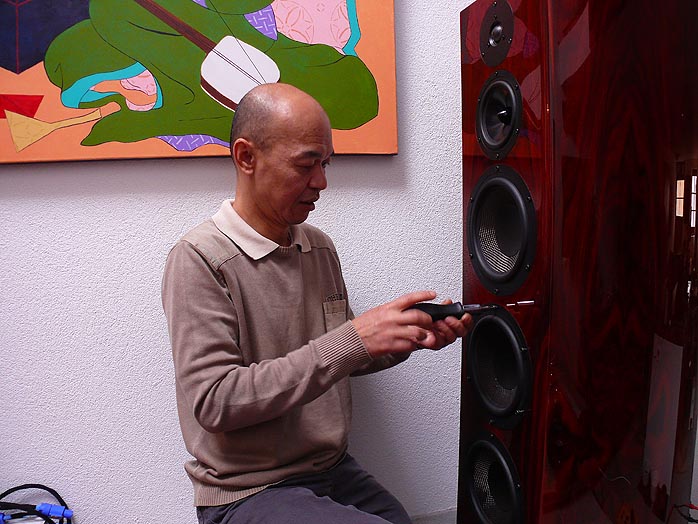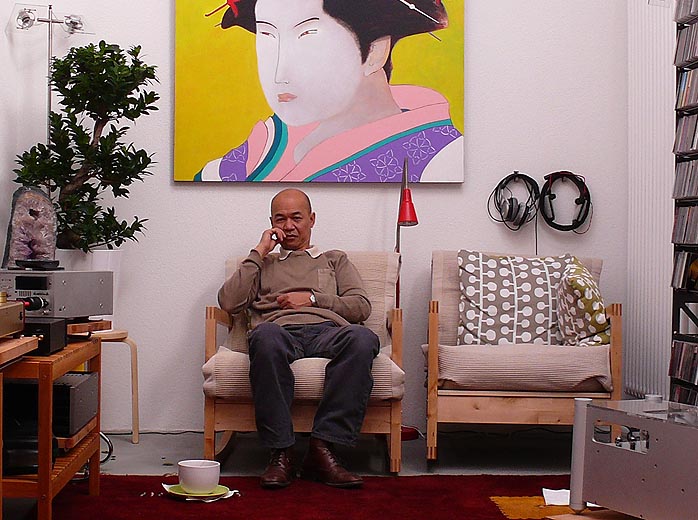|
|
|
|
|
This review page is supported in part by the sponsors whose ad banners are displayed below
|
|
 |
|
 |
 |
|
A breathing speaker
As Franck showed me while removing one of the woofers, the Carbon fiber layup of their cones has been deliberately woven such that when held against a bright lamp, there are visible little pin pricks of light penetrating between all fiber crossings. Couple that to the holes in the speaker's spine (tiny for the tweeter, about a 1/4" for the midrange, about four fingers' width for the woofers) and it's not at all literary license to call the Tango a breathing speaker. Of course only living things breathe. This points at a peculiarity of the Tango. It responds in a very organic interconnected way to very small internal and external changes.
|
|
 |
|
|
|
As delivered from Paris in a cold truck, the speaker at first sounded terribly compressed, hooded and dull. Franck rechecked torque on all woofer bolts. Likely due to our higher Swiss elevation, the bolts were far tighter than they'd been in Paris. By simply loosening them to retighten gently, the prior bass prominence receded and the midrange opened up to start breathing. This difference was far from subtle. We then experimented with the internal rosewood discs behind just one woofer per side. Rotating them by about 20 degrees increased bass damping. And so it went. Having commissioned Franck to treat our new residence with the resonators, noise filters and phase inverters from our Cyprus installation, he had timed his arrival with the delivery of the Tangos. Using his own speakers as reference, it was very instructive to observe his whole-house tuning progress and just how intimately the Tangos would respond invariably.
|
|
 |
|
|
|
He even closed off the midrange hole on the spine to demonstrate the immediate compression effects it had on the performance. The Tango then, far more than any other speaker in my experience, is an inanimate while 'living breathing' object. It requires sensitivity and skill to get the best from it. Its design very deliberately minimizes internal air pressures so that the drivers see a more closely matched radiation resistance in both directions of their stroke. Untreated compression zones in your room will 'feed back' more into this speaker's behavior than you're used to. It'll let you know without fail what's wrong with your room.
|
|
 |
|
|
If you're smart enough to recognize your acoustic issues, you'll fix them. The Tangos will instantly reward your efforts very handsomely because their range of responsiveness is higher than common. Blame the speaker instead and you'll suffer mediocre performance for quite a pretty penny. That's a sharply honed double-edged sword. It's not entirely surprising then that Mr. Tchang doesn't consider the Tango a commercial product at all. "The market is overcrowded as is. I have no intentions of fighting my way inside. I created the Tango as a commission and for my own pleasure. It incorporates everything I have learned about acoustics over the last 15 years. If and when audiophiles or music lovers encounter the Tango and wish to purchase it, I will accommodate them. But that's not my focus." (To this day, Mr. Tchang has no website but considers the time ripe to finally have one under development.)
|
|
 |
|
|
"To be honest, when I first started my guitar lessons, I couldn't hear so well. My teacher demonstrated tone modulations but it all sounded the same to me. Three months of lessons and practice later, my ears opened up. Today my design work is easy on that count. I play my guitar and compare how it sounds over my products." About the optional diamond tweeter, Franck Tchang was his usual blunt self: "With the 'R' version resonator array, I prefer the silk-dome tweeter. The diamond tweeter creates unnatural harmonics which of course affect everything else as well." About my 8-watt Yamamoto A-09S with EML 300B-XLS and 5U4G rectifier, Franck was astonished even though his Turkish distributor successfully uses a 6-watt SET. Still, Mercan Dede's Nefes with its powerful infrasonics had the designer at hello coming from a no-feedback triode amp. About my FirstWatt F5 he was so smitten, he already placed an order with Nelson Pass. His current reference is a 1200-watt Karan Acoustics behemoth, the very one he 'abused' my pair with to hasten break-in.
|
|
|
|
 |
|
Singularly on the breath
Once the Tango breathes freely, it behaves just like a single-driver speaker - with phenomenal bass and harmonic finesse to boot. Its resolution over a premium amp of the F5's caliber becomes such that at very subdued midnight levels, each bass note is like a dancer's elastic ghost on a sheet of stretched cellophane. Each turn of the foot, jump and landing imprints delicately as a whisper, with the relative weight on heel or toes clearly rendered and audible visibility extended all the way down. To hear low bass so elegantly at such faint levels is exhilarating like a heightened state of exquisitely honed perception. I felt like the ground upon which a kitten frolicked, the soil having become my expanded skin which registered each padded paw nearly intuitively no matter how ephemeral. Bass like a dancing cat in the twilight, the pitter patter of little pink tufted paws ... it's admittedly an unusual image but one that truly does capture the sensation.
|
|
 |
|
|
|
The same holds true for harmonic halos surrounding in particular stringed instruments. Just like the best high-efficiency designs, you can play very softly and hear all of this spiderwebby gossamer stuff which the 20 paralleled 32-bit AKM converters in my APL Hifi NWO 3.0 resolve with such finesse. You hear plainly how it modulates timbres with fine gradations in bow or finger pressure, blown air speed or bodily turns. Nothing obscures, congeals, overlays or thickens once the room supports truly full-range coverage without resonance. That's resolution, my dear Watson.
|
|
 |
|
| Arm chair designers will point out that with a vertical baffle, the Tango's 1st-order filters alone don't make for time coherence. Touché. On paper. In practice, the breath element of the design could be senior in import to preserve proper timing cues. Playback at very low levels |
|
|
again proves the point. When rain trees, tabla trills, clarinet key clacks and other such spectral noises are of proper size and without blur; when piano hammer falls don't fuzz up or peculiarly expand and contract over broad scales; when soundstage depth is cavernous and rendered with a very fine tip - then the dictates of clean timing must have been obeyed. At least that's what my ears tell me. The peanut gallery is free to cry foul.
To conclude first impressions, the Tango is a quite fussy operator that interacts with your room in a very intimate manner. With proper home work on your listening space behind you and proper AC polarity observed in your equipment, the Tango also is an exceptionally astute conveyor of information. It rivals the best single-driver designs in coherence but puts a blunt lie to their notion of the true meaning of 'full range'. The Tango is very fast if by that we mean, able to respond to minute impulses without hesitation. In many ways, the Tango is a floorstanding monitor speaker. A recording engineer intent on hearing everything would want it. Or someone experienced enough to understand setup intricacies and interconnectedness. You'd also want superior electronics (which need not be expensive when it comes to amplification as my Yamamoto and First Watt amps show).
|
|
|
 |
|
Most purveyors of consumer goods fall over backwards trying to sell you. The Tango and its maker Franck Tchang seem rather more reluctant. They nearly put the onus on you. Prove your worthiness as it were. This isn't meant derogatory. It merely reflects what's true for ownership of any finely calibrated, ultra high performance appliance. It takes preparation and skill to use one. The more so, the less convincing the results will be in the wrong hands. Incidentally, the name connects the speaker to Franck's Paris residence. Remember Marlon Brando and Maria Schneider in Bertolucci's Last Tango in Paris? Inherent in "last" is that this Tango won't have a sequel either. It's Franck's best effort already. He's not interested in less. Nor is he responsive to distributors clamoring for a "cost-no-object" object. Again, the Tango isn't a commercial project. It's one designer's best effort to please himself. And a few lucky, like-ear'd fellow travelers.
|
|
 |
|
|
The most surprising quality of the Tango perhaps is how its five drivers speak with a singular voice from a hesitant pianissimo to a gushing fortissimo. It's an easeful unforced quality as light as air. In a way, it reflects how our human sense of well-being peaks when we breathe freely down to our toes to feel full without constrictions or voids. But just as such well-being demands physical, mental and emotional discipline, so the breathing Tango speakers demand applied discipline. Then they become superbly calibrated empaths that let you hear what altering grain directionality of a small Indian rosewood disc behind a woofer accomplishes. Or applying just the right amount of mounting torque. Reversing directionality of an interconnect cable. Inserting wooden footers under a CD player. Or replacing a quality expensive power cord with ASI's own Liveline. Yes, such a beast now does exist. Users familiar with the Liveline interconnects will already know what to expect. They can also apply the interconnect's qualities of timing, speed, cohesiveness and energy to the Tango speakers. Simply multiply those effects by a considerable amount. As Franck would put it, "every designer puts his personality into his creations." The Tango does exactly what the Acoustic System resonators, noise filters and cables do. It simply applies Franck's craft to the vital audio junction where electrical impulses are converted into mechanical motions which pulse the sound carrier of air. That's perhaps why all of the Tango's unique contributions to the speaker art are entirely mechanical in nature. So think of its many holes as nostrils. Through them the Tango inhales and exhales with the music. That conveys a solid notion of what it feels like to listen to these elegantly appointed towers.
|
|
|
|
|
 |
 |
|
 |
|
|
|
|
|
|
|
|
|
|
|
|
|